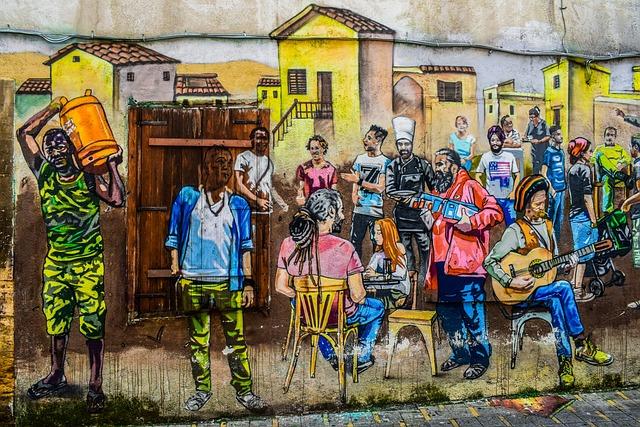In the heart of South Asia, Pakistan stands as a tapestry woven from the threads of diverse cultures, traditions, and histories. As the nation embarks on a journey of economic growth and globalization, the phenomenon of immigration has emerged as a pivotal force shaping its narrative. This article delves into the intricate interplay between immigration and Pakistan’s development trajectory, exploring how the influx of diverse populations has influenced the labor market, enriched cultural landscapes, and spurred innovation. By examining the multifaceted impacts of immigration, we seek to illuminate both the challenges and opportunities that accompany this dynamic force, ultimately painting a holistic portrait of a nation on the rise. Join us as we navigate the contours of Pakistan’s growth story, and uncover how its very essence is being reshaped by the movement of people across borders.
Shaping Economic Landscapes Through Diverse Talent
The intermingling of diverse talents in Pakistan has proven to be a powerful catalyst for economic rejuvenation. As a nation rich in cultural heritage and skilled individuals, the influx of immigrants has infused new ideas and perspectives into the existing workforce. This melting pot approach not only fosters innovation but also catalyzes productivity across various sectors. The unique backgrounds of these individuals contribute to a vibrant entrepreneurial ecosystem, showcasing how diversity can be harnessed to address complex challenges and drive sustainable growth.
Moreover, studies highlight the critical role that immigrants play in bridging skill gaps within the local economy. They bring with them specialized knowledge and expertise that complement the existing skills of the native workforce. This synergy is evident in areas such as technology, healthcare, and trade, promoting collaboration that enhances overall economic performance. The table below illustrates the sectors where immigrant contributions have been particularly impactful:
| Sector | Key Contributions |
|---|---|
| Technology | Innovative startups and software development |
| Healthcare | Skilled medical professionals and specialists |
| Manufacturing | Enhanced production techniques and efficiency |
| Agriculture | Advanced farming practices and crop diversification |

Cultural Fusion: Enriching Pakistans Social Fabric
The influx of diverse immigrant communities into Pakistan has contributed significantly to the nation’s cultural tapestry, creating a vibrant mosaic that celebrates differences. This blending is most palpable in urban centers like Karachi and Lahore, where traditional Pakistani customs intertwine with the unique practices of various ethnic groups. Culinary arts, for instance, showcase this cultural amalgamation, as restaurants serve dishes that marry Punjabi flavors with Persian spices or street food that reflects Afghan tastes. The arts and crafts sector also thrives in this environment, with artisans drawing inspiration from a spectrum of cultural backgrounds to innovate and revitalize traditional practices.
Moreover, the social fabric of Pakistan has been further enriched by the educational contributions of immigrant families, who prioritize knowledge and skills, fostering a culture of learning across communities. Cultural festivals celebrate this diversity, with events highlighting various heritages, allowing for an exchange of ideas and traditions. The evolution of language in urban areas also illustrates this impact, as dialects blend and new phrases emerge, reflecting the shared realities of a multi-ethnic society. As immigrants settle and flourish, they not only bring their legacies but also participate in a collective narrative that strengthens Pakistan’s identity amidst globalization.

Navigating Challenges: Policy Recommendations for Sustainable Integration
To harness the potential of immigration for Pakistan’s growth, a multi-faceted approach is required, focusing on policies that promote inclusivity and integration. First and foremost, the establishment of clear legal frameworks is essential to ensure that immigrants have access to opportunities while protecting local labor markets. This includes the introduction of temporary work permits tailored to demand in key sectors, facilitating a structured entry for skilled and unskilled labor. Additionally, creating support systems such as community centers that offer language and vocational training will empower newcomers, enabling them to contribute effectively to the economy.
Furthermore, collaboration between government agencies, private sector players, and civil society organizations is crucial in crafting sustainable integration policies. This entails conducting impact assessments to address the specific needs of immigrant populations and their host communities. Considerations should include the following key initiatives:
- Public Awareness Campaigns: Foster positive narratives around immigration.
- Health and Social Services Access: Ensure immigrants can utilize public resources without barriers.
- Job Matching Programs: Connect immigrants with local businesses seeking workforce expansion.
| Policy Initiative | Description |
|---|---|
| Legal Frameworks | Establish clear guidelines for immigrant entry and employment. |
| Support Systems | Offer language and vocational training to enhance local integration. |
| Community Collaboration | Engage multiple stakeholders to provide comprehensive support. |

Harnessing Remittances: Boosting Development and Investment Opportunities
Remittances have emerged as a critical pillar for Pakistan’s economy, directly impacting its developmental trajectory by channeling vital funds back into the local economy. With millions of Pakistanis working abroad, the flow of remittances has surged, providing families with enhanced purchasing power and improved living standards. This influx of foreign currency not only stabilizes the national currency but also fuels local businesses and services, creating a ripple effect that enhances overall economic activity.
In addition to bolstering household incomes, remittances serve as a catalyst for investment opportunities across various sectors. Families receiving these funds are more likely to invest in education, healthcare, and entrepreneurship, fostering a climate of innovation and growth. Key areas where remittances can make a significant impact include:
- Property Development: Increased purchasing power leads to investments in housing and infrastructure.
- Small and Medium Enterprises (SMEs): Many families use remittance funds to start or expand their businesses.
- Education: Families prioritize education, investing in schooling and vocational training for the next generation.
To illustrate the scale of this impact, consider the following data on remittance inflows and their allocations:
| Year | Remittance Inflows (USD Billion) | Investment Sectors |
|---|---|---|
| 2020 | 23.1 | Real Estate, Education, Healthcare |
| 2021 | 29.4 | SMEs, Agriculture, Technology |
| 2022 | 31.2 | Tourism, Infrastructure, Renewable Energy |
By effectively harnessing remittances, Pakistan can unlock its potential for sustainable growth and development, paving the way for a brighter future. The confluence of increased remittance flows and focused investment strategies could very well redefine the nation’s economic landscape.
In Conclusion
the narrative of immigration in Pakistan is a multifaceted one, woven intricately into the fabric of the nation’s history and growth. As we have explored, the contributions of immigrants—whether they are returning expatriates or newcomers seeking refuge—extend far beyond economic metrics. They enrich the cultural landscape, foster innovation, and invigorate local communities.
Understanding this impact is not merely an academic exercise; it informs policy decisions, shapes public perception, and ultimately guides the path toward a more inclusive future. As Pakistan continues to navigate the complexities of globalization, it becomes ever more crucial to recognize and harness the potential of its immigrant population.
In embracing the diversity that immigration brings, Pakistan stands at the cusp of transforming challenges into opportunities. The journey is ongoing, filled with trials and triumphs, but one truth remains clear: immigration has and will continue to play a significant role in shaping the country’s growth story. As we look forward, it is essential to foster dialogue, enhance collaboration, and build bridges that celebrate the invaluable contributions of all who call Pakistan home.



